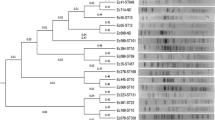Abstract
The purpose of this study was to investigate the prevalence of β-lactamase and the genomic clonality of a large collection of Kingella kingae isolates from Israeli patients with a variety of invasive infections and asymptomatic pharyngeal carriers. β-lactamase production was studied by the nitrocefin method and the minimum inhibitory concentrations (MICs) of penicillin and amoxicillin–clavulanate were determined by the epsilon (Etest) method. The genotypic clonality of isolates was investigated by pulsed-field electrophoresis (PFGE). β-lactamase was found in 2 of 190 (1.1 %) invasive isolates and in 66 of 429 (15.4 %) randomly chosen carriage organisms (p < 0.001). Overall, 73 distinct PFGE clones were identified (33 among invasive organisms and 56 among carriage isolates). β-lactamase production was found to be limited to four distinct PFGE clones, which were common among carriage strains but rare among invasive strains, and all organisms in the collection belonging to these four clones expressed β-lactamase. The penicillin MIC of β-lactamase-producing isolates ranged between 0.094 and 2 mcg/mL (MIC50: 0.25 mcg/mL; MIC90: 1.5 mcg/mL) and that of amoxicillin–clavulanate between 0.064 and 0.47 mcg/mL (MIC50: 0.125 mcg/mL; MIC90: 0.125 mcg/mL). The penicillin MIC of β-lactamase non-producing isolates ranged between <0.002 and 0.064 mcg/mL (MIC50: 0.023 mcg/mL; MIC90: 0.047 mcg/mL). Although β-lactamase production is prevalent among K. kingae organisms carried by healthy carriers, the low invasive potential of most colonizing clones results in infrequent detection of the enzyme in isolates from patients with clinical infections. The exceptional presence of β-lactamase among invasive organisms correlates with the favorable response of K. kingae infections to the administration of β-lactamase-susceptible antibiotics.
Similar content being viewed by others
References
Chometon S, Benito Y, Chaker M, Boisset S, Ploton C, Bérard J, Vandenesch F, Freydière AM (2007) Specific real-time polymerase chain reaction places Kingella kingae as the most common cause of osteoarticular infections in young children. Pediatr Infect Dis J 26:377–381
Yagupsky P, Porsch EA, St Geme JW 3rd (2011) Kingella kingae: an emerging pathogen in young children. Pediatrics 127:557–565
Yagupsky P, Dagan R, Prajgrod F, Merires M (1995) Respiratory carriage of Kingella kingae among healthy children. Pediatr Infect Dis J 14:673–678
Yagupsky P, Porat N, Pinco E (2009) Pharyngeal colonization by Kingella kingae in children with invasive disease. Pediatr Infect Dis J 28:155–157
Birgisson H, Steingrimsson O, Gudnason T (1997) Kingella kingae infections in paediatric patients: 5 cases of septic arthritis, osteomyelitis and bacteraemia. Scand J Infect Dis 29:495–498
Sordillo EM, Rendel M, Sood R, Belinfanti J, Murray O, Brook D (1993) Septicemia due to β-lactamase-positive Kingella kingae. Clin Infect Dis 17:818–819
Von Graevenitz A, Zbinden R, Mutters R (2003) Actinobacillus, Capnocytophaga, Eikenella, Kingella, Pasteurella, and other fastidious or rarely encountered gram-negative rods. In: Murray PR, Baron EJ, Jorgensen JH, Pfaller MA, Yolken RH (eds) Manual of clinical microbiology, 8th edn. ASM Press, Washington DC, pp 614–615
Clinical and Laboratory Standards Institute (CLSI) (2010) Methods for antimicrobial dilution and disk susceptibility testing of infrequently isolated or fastidious bacteria; Approved guideline—second edition. Document M45-A2, vol. 30, pp. 22–23
Maslow JN, Slutsky AM, Arbeit RD (1993) Application of pulsed-field gel electrophoresis to molecular epidemiology. In: Persing DH, Smith TF, Tenover FC, White TJ (eds) Diagnostic molecular microbiology: principles and applications. ASM Press, Washington DC, pp 563–572
Tenover FC, Arbeit RD, Goering RV, Mickelsen PA, Murray BE, Persing DH, Swaminathan B (1995) Interpreting chromosomal DNA restriction patterns produced by pulsed-field gel electrophoresis: criteria for bacterial strain ty**. J Clin Microbiol 33:2233–2239
Pfaller MA, Farrell DJ, Sader HS, Jones RN (2012) AWARE Ceftaroline Surveillance Program (2008–2010): trends in resistance patterns among Streptococcus pneumoniae, Haemophilus influenzae, and Moraxella catarrhalis in the United States. Clin Infect Dis 55(Suppl 3):S187–S193
Amit U, Dagan R, Yagupsky P (2013) Prevalence of pharyngeal carriage of Kingella kingae in young children and risk factors for colonization. Pediatr Infect Dis J 32:191–193
Rossignoli A, Clavenna A, Bonati M (2007) Antibiotic prescription and prevalence rate in the outpatient paediatric population: analysis of surveys published during 2000–2005. Eur J Clin Pharmacol 63:1099–1106
Brueggemann AB, Griffiths DT, Meats E, Peto T, Crook DW, Spratt BG (2003) Clonal relationships between invasive and carriage Streptococcus pneumoniae and serotype- and clone-specific differences in invasive disease potential. J Infect Dis 187:1424–1432
Amit U, Porat N, Basmaci R, Bidet P, Bonacorsi S, Dagan R, Yagupsky P (2012) Genoty** of invasive Kingella kingae isolates reveals predominant clones and association with specific clinical syndromes. Clin Infect Dis 55:1074–1079
Conflict of interest
The authors declare that they have no conflict of interest. No funding of any kind has been received. The data have not been generated as part of the routine work for any organization.
Author information
Authors and Affiliations
Corresponding author
Rights and permissions
About this article
Cite this article
Yagupsky, P., Slonim, A., Amit, U. et al. Beta-lactamase production by Kingella kingae in Israel is clonal and common in carriage organisms but rare among invasive strains. Eur J Clin Microbiol Infect Dis 32, 1049–1053 (2013). https://doi.org/10.1007/s10096-013-1849-1
Received:
Accepted:
Published:
Issue Date:
DOI: https://doi.org/10.1007/s10096-013-1849-1




